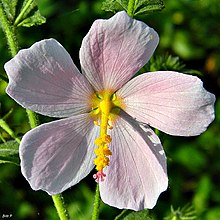Kosteletzkya pentacarpos
| Seashore mallow | |
|---|---|

| |
| Scientific classification | |
| Kingdom: | Plantae |
| Clade: | Tracheophytes |
| Clade: | Angiosperms |
| Clade: | Eudicots |
| Clade: | Rosids |
| Order: | Malvales |
| Family: | Malvaceae |
| Genus: | Kosteletzkya |
| Species: | K. pentacarpos
|
| Binomial name | |
| Kosteletzkya pentacarpos | |
| Synonyms | |
|
Kosteletzkya virginica | |
Kosteletzkya pentacarpos, the seashore mallow, also known as the saltmarsh mallow, sweat weed, Virginia saltmarsh mallow, or hibiscus à cinq carpelles, is an
Taxonomy
This flowering plant is in family Malvaceae of the order Malvales. Populations in North America were previously known as Kosteletzkya virginica to distinguish them from the Eurasian K. pentacarpos, but both species were merged in 2008 due being morphologically identical to one another.[2][3][4]
Description
The pink-flowered seashore mallow is both a
Distribution
This species is found throughout much of the Atlantic and Gulf coastlines of eastern North America, from New York south to Cuba, east to Bermuda, and west to Texas. It also has a fragmented distribution along the Mediterranean shoreline of southern Europe, including parts of coastal Spain & Italy, the Balearic Islands, and Corsica. Populations in northern Italy are thought to be introduced. One very small population is known from Georgia, on the coast of the Black Sea. It is also found along the western and southern shorelines of the Caspian Sea in Iran and Azerbaijan. This species is also found along the Volga and Don Rivers in southwestern Russia, but it is unknown whether these populations have natural origins.[1]
Threats
While this species is common throughout its North American range, populations in Eurasia are rare and have been severely fragmented by agricultural and urban development, and over the past few decades it has been lost from many localities where it was previously known.[1][4][7]
Uses
In ancient Transcaucasia, K. pentacarpos and Hibiscus ponticus were abundant enough to be harvested in large numbers for their strong stem fibers, which were useful for making ropes and nets.[1] In addition, studies indicate that K. pentacarpos is a potentially useful species for phytoremediation of saline soils polluted by metalloids, and can also facilitate the transition of coastal agricultural land to wetlands following sea level rise.[8][9][10]
References
- ^ . Retrieved 27 June 2022.
- ^ a b "Kosteletzkya pentacarpos (L.) Ledeb. | Plants of the World Online | Kew Science". Plants of the World Online. Retrieved 2022-06-27.
- ^ "Kosteletzkya pentacarpos - Species Details". Atlas of Florida Plants. Retrieved 2022-06-27.
- ^ S2CID 86244333.
- ^ Ed Weislo. "Florida Wildflowers". Florida's Nature. Retrieved 2015-05-11.
- ISBN 0807855979.
- ISSN 0024-4074.
- PMID 34834857.
- S2CID 4885818.
- S2CID 83992477.

